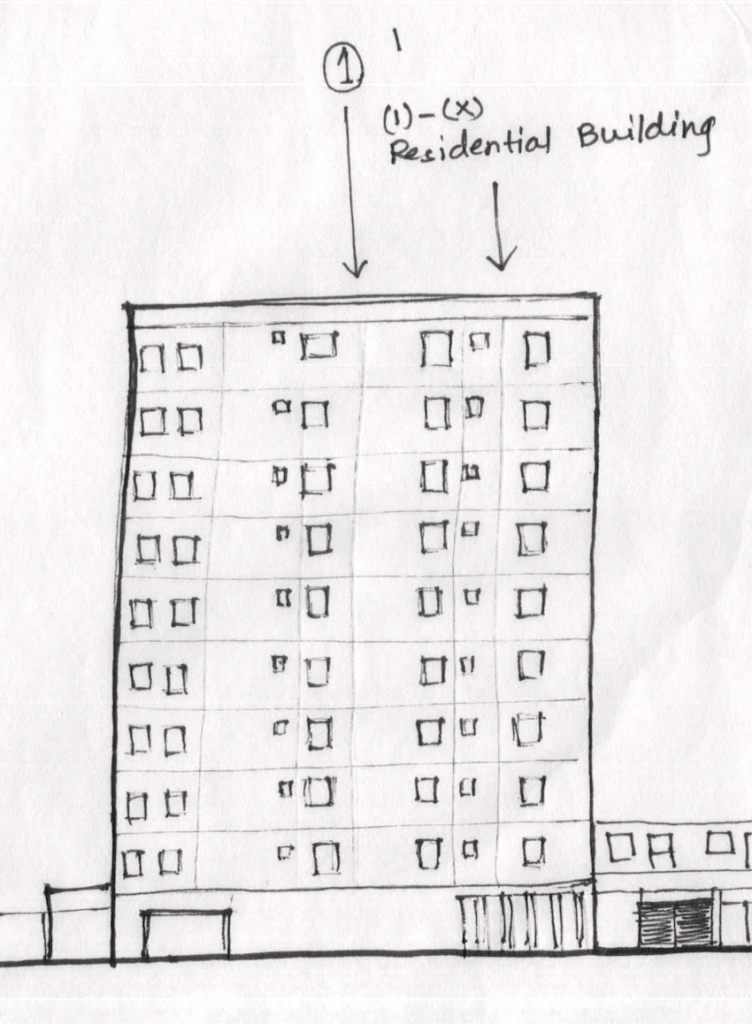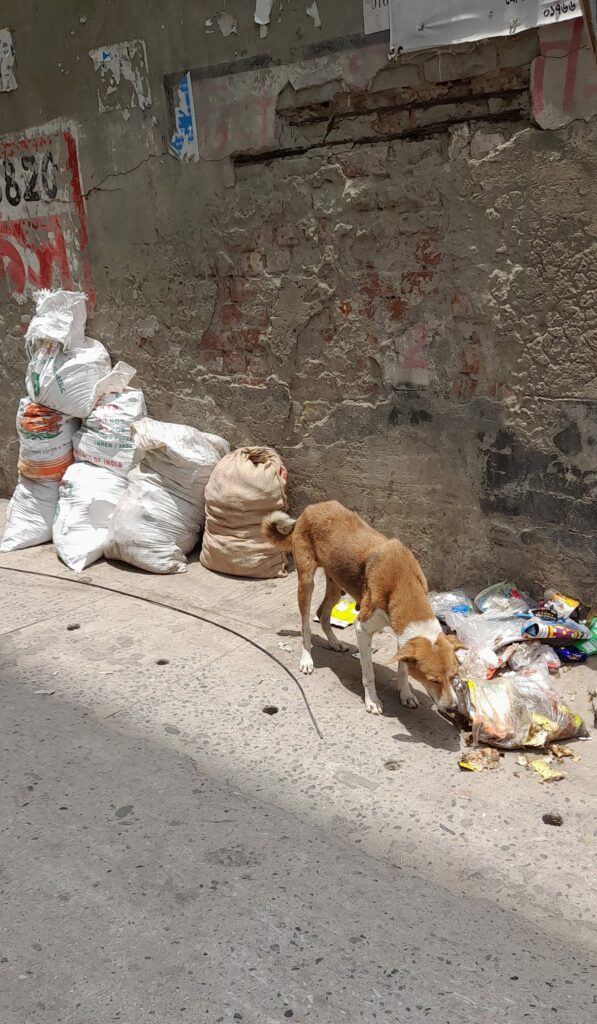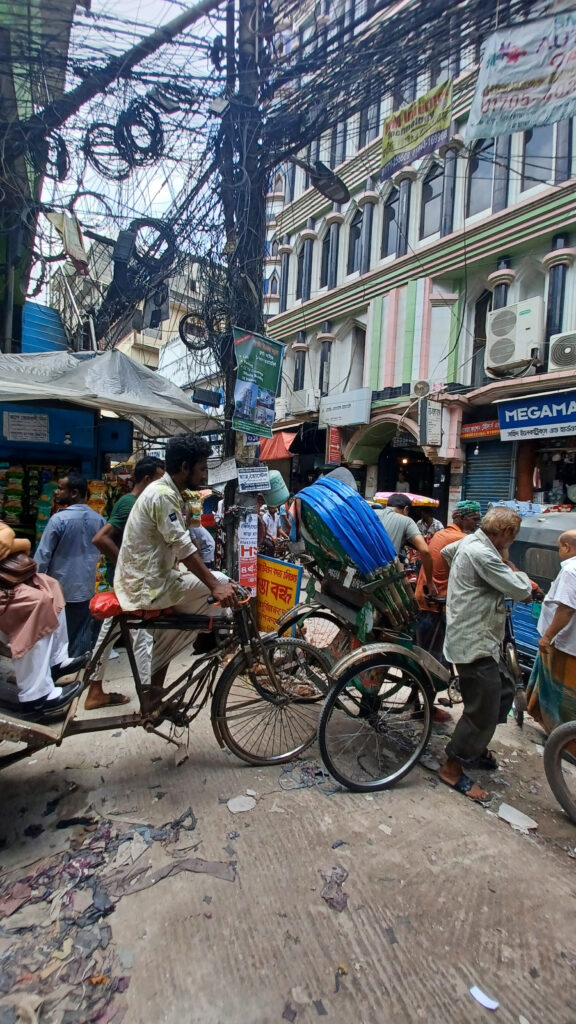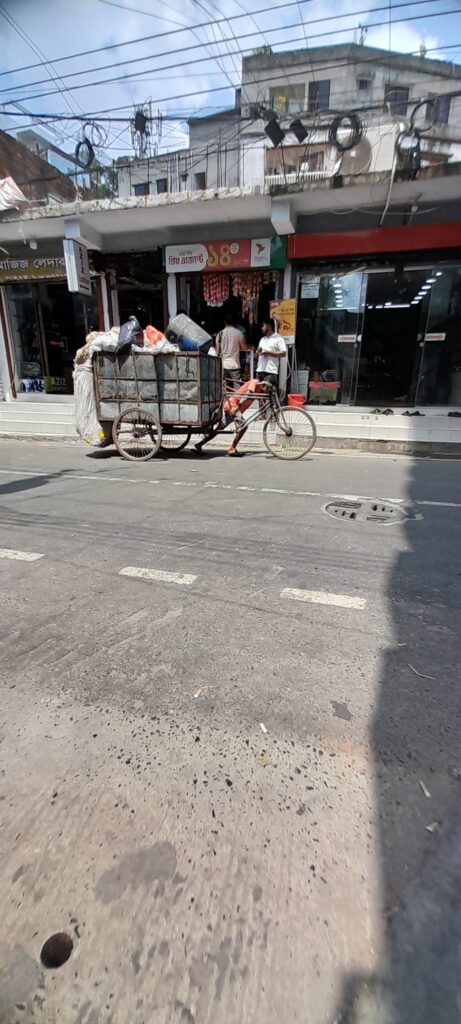
A vibrant, poorly serviced, retail centre: How a street has grown around the leather factories and shops of Hazaribagh, Dhaka
Hazaribagh is the historic centre of leather processing and production in the city of Dhaka, Bangladesh. Many of the road names – Royal Tannery Lane, Bangla Tannery Road – indicate its recent past as a tannery zone, making leather from raw cow and goat hides. In 2023 around 150 small and medium enterprises were operational in Hazaribagh making leather gloves, shoes and other leather products.
Situated along the Buriganga river, Hazaribagh is densely packed with multi-story residential settlements, situated above, beside and behind commercial units and leather factories. There is very little space in the centre of Hazaribagh, with narrow roads and alleyways between buildings (see map).
On 24th July 2023, two child researchers, along with accompanying CLARISSA adult researchers conducted observations of one street, Sher E Bangla Road, in Gojmohol, Hazaribagh to capture the living conditions and lived experience of residents. The diagrams and maps and illustrations of buildings were drawn by an illustrator and all research observation notes, photos and videos were analysed by the CLARISSA research team and the children before the main findings were compiled into this account.
Sher E Bangla Road is widely recognised as a highly dynamic and bustling thoroughfare within the slum neighbourhood of Gojmohol. Home to approximately 1,650 households and 2,450 children (according to a census conducted in November ), the majority of the residents of this street experience poverty. Many migrated here in search of work. People living on this street navigate insecure living conditions, limited access to schooling and a lack of healthcare provision. Many of the children who live in the neighbourhood are child labourers. The street was mapped in detail by the CLARISSA team, following several field visits. Particular attention was paid to mapping the dimensions of buildings, as well as buildings use, including residential, commercial, factory or warehouse (“godowns”) and mixed use.

An aerial map of Hazaribagh. The majority of the map is green, which illustrates concentrated urban development. The street of focus is located in the northern part of the map, an area with no open spaces, playgrounds or vegetation cover.

Street description
Sher E Bangla Road
- Residential Building
- Commercial Building
- Factory or warehouse
- Mixed Used
- Mosque
- Shop
- Garage
- Electricity Office
- Water Pump
Hand-drawn aerial street map created by researchers and accompanying illustrator.


The entrance at one end of Sher E Bangla Road has large mixed-use buildings opposite one another.
Sher E Bangla Road intersects with the primary thoroughfares of Mohammadpur and Rayerbazar. The road is segmented into multiple sub-roads, with several alleyways integrated into its network. The road is larger than other roads in the vicinity. The street is noticeably cleaner and more spacious than some others around it, although it is also busy with traffic. The road is in close proximity to the local police station.

The diversity of commercial units on the street. Some commercial units have residential floors above.
There is a prominent central mosque located at one end of the street, renowned as one of the largest mosques in the vicinity. Further along the road are various establishments such as banks, medical stores, department stores, hardware and glass shops, furniture showrooms, bakeries, tea stalls and a restaurant. There are also mechanical repair units, where televisions, refrigerators, and air conditioners are serviced and restored.

An example of a mid-rise residential building on the street.
Some commercial properties are single story but the buildings taller than one story, many have one or two residential floors. There are only three mid-rise buildings on the street that are exclusively residential.

One side of the street is mainly single-story footwear shops, leather factories and storage spaces and the other side is more a mix of multipurpose buildings.
There is a large leather factory in the middle of the street, but the majority of the remaining stretch of the road is comprised of around 50 smaller businesses specialising in the sale of leather goods. These stores sell a wide range of products including footwear bags, wallets, jackets etc. Most are single-level structures Some have floors above them comprising residential spaces and madrasas (Islamic schools).
Each leather store has its own leather production factory located in close proximity. It is more common to find children working in these factories than in the stores. Many of the store showrooms are leased. The rental rates range from BDT 8,000 to BDT 12,000 BDT (US $72 to $ 108) a month.
Many of the street’s residential buildings are located in alleyways or on side streets, which is a slightly more tranquil environment. These buildings are typically four to five stories in height. The majority of residents have middle-income levels.
There are a number of educational coaching centers, as well as several madrassas in the vicinity. The street also is busy with food and tea stalls, particularly outside the leather factories and schools.
Sounds of Sher e Bangla
Sounds during a traffic jam
Characteristics of the street

An illustration of a middle section of Sher E Bangla Road.
The street is narrow and lined with shops. Goods are transported up and down the street in hand pulled carts. There are no open drains -drainage is located underground. Above the shops people live and children go to school. There are no trees or any kind of greenery on the street.
The street is busy with traffic, including autorickshaws, mini trucks, cargo vans, personal cars, motorcycles and there is constant sound.

Rickshaws passing by street vendors
The street is narrow and lined with shops. Goods are transported up and down the street in hand pulled carts. There are no open drains -drainage is located underground. Above the shops people live and children go to school. There are no trees or any kind of greenery on the street.
The street is busy with traffic, including autorickshaws, mini trucks, cargo vans, personal cars, motorcycles and there is constant sound.
There is frequent and heavy congestion. The middle portion of the street is wide enough for two big vehicles to pass but at each end of the street it is only wide enough for two rickshaws to pass simultaneously. Attempts by two large vehicles to pass each other creates traffic build up and accidents are common. You can constantly hear the sounding of horns.
Vans and trucks deliver leather goods, including raw and dried leather and chemicals. Police vans regularly patrol the road.
The road is consistently populated with pedestrians, especially during lunchtime and in the evening, when workers from various factories make their way home. Many children, unaccompanied by adults, make their way back from school or work. School vans also transport children to and from school.
Children on the street
Children pass through this street on their way to school or attend school or coaching on this street, but many children also work as child labourers on this street.
A considerable proportion of the students attending school and coaching sessions were observed to be female. The research team estimated that double the number of girls as boys were seen travelling to and from school.
The research team observed many children working on the street. Children were seen working in furniture-making shops, mechanical workshops, restaurants, and tea stalls. Children were also seen transporting products and children were seen working in leather factories on the street.
Examples of children observed working on the street included: A boy of around 12 helping to run a tea stall, and carrying a water container that was taller than him; a boy working in a mechanical workshop operating a welding machine without safety equipment; a child operating an iron cutting machine; several children in furniture establishments using hammers, saws and other hazardous tools.
The researchers also saw a boy of 12 at the oldest pulling a heavy cart of rubbish, in the oppressive heat. He was wearing tattered trousers and was naked from his waist up and had bare feet. His feet were black with dirt, and he generally looked disheveled and was soaked with sweat. The cart seemed way too heavy for him and seemed at great risk of serious injury.
Another boy around the same age was seen carrying two gas containers, one on his shoulder and another in his left hand. He was also covered in sweat and looked to be in great discomfort.
At lunch time, many child workers from nearby leather factories were seen walking along the streets. The proportion of boys and girls was approximately equal.
Two teenage boys were seen calling out to young girls as they walked past.
Hey, beautiful! Why don’t you respond? I have sent you a friend request on Facebook; why don’t you follow me back? If you don’t want, then at least give me your friend’s phone number!
The young girls, who were around 14 were giggling with each other.
Fewer children were observed working in the various leather products shops. (Only one boy was seen working in one of the shops. He was seen getting snacks and tea for the owners and running small errands, he seemed to be treated well and was later seen playing football in the street).
Shop owners seem to prefer adult employees to children It is also worth noting that there were very few customers frequenting these shops during the observation period. According to the vendors, customers are less willing to spend at the end of the month and outside festival seasons.
Elsewhere on the street child vendors were not treated the same as adult vendors. A boy of around 13 who set up his mobile vending cart in front of the entrance to a leather factory was moved on by the security guard, but the CLARISSA team observed that adult vendors were not moved on in the same way.
This incident broke my heart and made me feel very sorry for that poor boy. When we were young, sometimes we were also treated like that by our seniors. Child Researcher, 15 years old
Lighting
There is a noticeable absence of streetlights on the road. In the evening, the road is lit by lights emanating from the shops. There is an intersection that provides connectivity between alleyways and the main road.
At the intersection, there is a single streetlight. While the road itself is lit by the shops, the alleyways are not:
Upon their departure from Sher E Bangla Street, the research team took an adjacent alleyway, that was dimly lit. Some teenage boys were gathered at the far end of the alley smoking marijuana, and this made the research team feel uneasy.

No streetlights are observed on the main street; however, the entire road is illuminated by lights coming from shops. Though there are some corners and alleyways they were still dark Adult Researcher

Street intersection with one light to illuminate the road and connecting alleyways.
Water
Water is not supplied to individual buildings on the street. Dhaka Water Supply and Sewerage Authority offers a water vending facility where local residents can obtain water at a rate of BDT 0.7 BDT (US $ 0.006) per litre. Several vans carrying water containers were observed, mainly near residential dwellings, suggesting that some people buy their drinking water. These containers cost BDT 50 (US $0.46) each.

A van carrying rubbish

A dog scavenging from a bag of rubbish.
Waste
One of the store proprietors was observed expressing dissatisfaction with the insufficient presence of rubbish bins along the street. During the course of the day, the team observed the arrival of four vans from the city corporation’s waste management department transporting rubbish from the streets and two of the adjacent households but also observed that this is insufficient for the demand, as rubbish remained on the street and was causing insanitary conditions for those working and living along it.
A van full of rubbish is here. Two men are working here with their bare hands. They collect and keep the waste in the van. They are touching their face and other body parts. It can lead them to any accident or disease. A dog is eating filth from the side of the van. A bad smell has spread. Child Researcher, 17 years old
High temperatures
The research team observed the street on a very hot day.
The day is characterized by unusually high temperatures and excessive heat, reminiscent of a scorching summer day. Throughout the course of the day, the presence of shadows is relatively minimal. The road gets very hot under the blazing sun. The shop owners are continually splashing water on the road in order to mitigate the effects of heat and airborne dust. I am feeling a sense of unease and discomfort. I am also feeling quite sick, due to remaining outdoors during daylight hours. I cannot stand it anymore; I need to sit. The heat is making the dogs fight. Child researcher, 15 years old
Constant load-shedding is making the heat scenario worse. The power is always being cut. Most of the shopkeepers are now sitting outside their shops fanning themselves. The situation does improve in the evening as breezes blow in. Also, loadshedding doesn’t happen in the evenings. Adult researcher

Gas and electricity services
A big issue for residents of the street is the gas supply. Some residents told the research team that the residents owe BDT 96,000,000 (US $876,000) to the primary gas supplier authority, which has led to the discontinuation of all gas services in their locality. Cylinder gas is being used on the street as an alternative and the research team observed multiple trucks transporting gas cylinders throughout the day.
There is a noticeable presence of electrical infrastructure and wiring in the vicinity of the street. Residents also experience intermittent electricity supply due to ‘load shedding’. In Dhaka, ‘load shedding’ is a term used to describe government-scheduled cuts in the electricity supply to manage usage.

A cup at a tea stall that is used by different customers without being cleaned

A mobile street stall selling food.
Poor food hygiene
The research team observed poor hygiene practices in many restaurants, food hotels, and tea stalls along the street. Food was served from dirty hands and cups were washed with water that looked dirty.
A street food vendor was observed wiping sweat from his brow and subsequently handling and serving food.
There are multiple tea stalls located along the road. The tea stalls experience a high volume of customers during the lunch period. The primary clientele are workers from neighboring factories, shopkeepers and rickshaw pullers. They gather at the tea stall, buying tea, bananas, and buns for their lunch. There is lots of chat about the shortage of gas within the community.
There is a line of customers in a local restaurant, by the end of the road, buying and eating breakfast items. The restaurant is not so well maintained. The employees are serving food, and their hands are sweaty and dirty. The customers also eat without first washing their hands. There’s only one glass and everyone is drinking from it.. I didn’t want to drink from it, but I was really thirsty, so I did. Child researcher, 15 years old
The experiences of girls and women on the street
The research team observed that lots of the female students on their way to school and coaching centers were accompanied by adult guardians. This is presumed to be a protection from sexual harassment. During the day of observation, a man persistently trailed and harassed a female researcher on the street, causing her significant distress.
Discussion
Sher E Bangla Road is a vibrant retail centre where many leather businesses sell their products from brightly lit showrooms. The leather product shops are occasionally punctuated by large leather factories, as well as convenience stores, mosques, madrasas and banks. The middle of the street particularly congested with traffic, the transit of leather goods and mobile food stalls.
Despite being an important thoroughfare for commerce and journeys to school and work, the street has little in the way of facilities and infrastructure. It is poorly lit, poorly serviced by gas, electricity, water and waste removal. Many children and adults eat in tea stalls, cafes and hotels which have low hygiene standards. A striking number of traffic accidents occur on the street (in just five hours the CLARISSA research team witnessed three accidents and narrowly escaped another). Unaccompanied children walking along the road are at a high risk of accidents.
Children are a significant presence on the street, and many of them are present due to their work, despite being very young. Children as young as 12, especially boys were seen doing physically demanding, or socially demanding jobs. Children were seen being humiliated by their superiors and discriminated against.
Reflecting on the process of observing the street, the child researchers both felt that they had seen new things on a road they frequent often. The 15-year-old boy was more keenly aware of the dirt, rubbish and traffic congestion and dangers (and the need for more intervention from the authorities)
The story of Sher E Bangla Road illustrates the extent to which commercial variety and social infrastructure (e.g., places to learn and pray) has grown around leather factories and shops to service the population of the Gojmohol neighbourhood. The development of commercial and social spaces has outstripped the physical infrastructure of the street and the services – gas, water, electricity, waste management – that such a bustling location demands. The result is an urban neighbourhood that is not at all child-friendly, despite the prevalence of children on the street.
The neighbourhood mapping process
CLARISSA neighbourhood mapping work sought to understand children’s experience of urban neighbourhoods and to identify the characteristics of urban neighborhoods that contribute to the emergence and perpetuation of worst forms of child labour. The research team was interested in mapping a neighbourhood where different elements of leather processing and production are represented and where children are known to work. Children residing in the Gojmohol neighbourhood of Hazaribagh selected Sher E Bangla Road to map because it is a bustling area which lots of children frequent on their way to school and work, as well as to buy food. The street also has a variety of shops and workplaces and is a popular area to hang out.
To map the structure of the street two boys aged 16 and 17 years old were joined by community mobilisers working with CLARISSA and a photographer and illustrator. They sketched the layout of the road and took photos and videos to support their sketches and observations of the physical environment. The children collected information about the activities taking place within each building. This information was provided to the illustrator to help him to complete the illustrations.
For street observations the research team included two boys aged 16 and 17 years old and an adult researcher.. As the children were residents of the area, they could contribute with their local knowledge and insights of the street. The children proposed observation times: two hours in the morning between 10.30-12.30pm, one hour in the afternoon between 1-2pm and two hours in the evening from 5.30-7.30pm. They did not want to continue observations after 7.30pm due to safety concerns. It was agreed that the research team would not enter budlings, but they were able to observe the inside activities of tea stalls hotels and other shops from the street.
On 24th July 2023 the research team comprising two child researchers, and four adult members of the CLARISSA research team immersed themselves in the day-to-day life of the street. The team utilised a combination of direct observations, interactions with inhabitants, and documentation of the street structure. The research team were particularly focused on making observations about the physical environment and environmental hazards, about the activities of children living on the street and about how things changed over the course of the day, noting interactions between environmental variables like heat and light and people’s behaviour.
To observe 400 metres of street, the research team organised the street into sections. Each member was responsible for specific observations and after 10-15 minutes the team moved onto a new section. The team documented their observations using notebooks and mobile devices. The children who were not comfortable with writing used voice recorders to document their observations. They also took photos and audio recordings of the street.
The day after the observations, the CLARISSA research team and the children came together for a debriefing session. They shared their overall experiences and discussed their observations in detail. Notes were compiled from these discussions and all audio recordings were reviewed.












